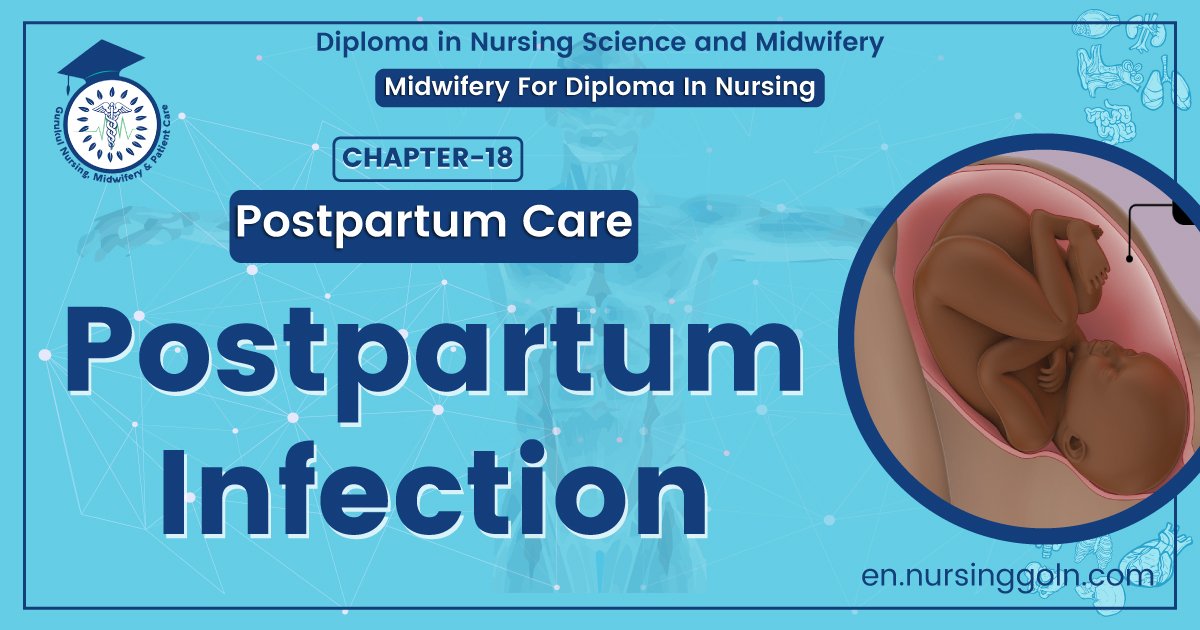Postpartum Infection – This course is designed to understand the care of pregnant women and newborn: antenatal, intra-natal and postnatal; breast feeding, family planning, newborn care and ethical issues, The aim of the course is to acquire knowledge and develop competencies regarding midwifery, complicated labour and newborn care including family planning.

Postpartum Infection
Postpartum infection
The term postpartum infection is used to refer to different types of infections that happen after a vaginal or a caesarean birth or during the stages of breastfeeding While it is normal to experience some amount of bleeding or fatigue after the birth, there are certain conditions that actually require a more detailed medical examination and cure.
Uterine infections include
- Infection of the uterine lining (endometritis).
- Infection of uterine muscle (myometritis),
- Infection of the areas around the uterus (parametritis).
Common postpartum infection
1. Endometritis, an infection of the endometrium (uterine lining).
2. Mastitis, a breast infection.
3. Infected incision.
4. Urinary tract infection.
Causes of postpartum infection
Bacteria that normally live in the healthy vagina can cause an infection after delivery. Conditions that make a woman more likely to develop an infection include the following:
1. Anemia
2. Bacterial vaginosis.
3. Repeated vaginal examinations during labor.
4. Internal monitoring of the fetus (which requires rupture of the membranes containing the fetus).
5. A long delay (often more than 18 hours) between rupture of the membranes and delivery.
6. Prolonged labor.
9. Excessive bleeding after delivery (postpartum hemorrhage).
10. Young age.
11. Low socioeconomic group.
The chances of developing a uterine infection depend mainly on the type of delivery:
- Normal vaginal deliveries: 1 to 3%,
- Caesarean deliveries that have been scheduled and are done before labor starts: 5 to 15%.
- Caesarean deliveries that are not scheduled and are done after labor starts: 15 to 20%.
Symptoms and signs may include
1. Fever.
2. Pain in the lower abdomen or pelvis caused by a swollen uterus.
3. Foul-smelling vaginal discharge.
4. Pale skin, which can be a sign of large volume blood loss.
5. Chills.
6. Feelings of discomfort or illness.
7. Headache.
8. Loss of appetite.
9. Increased heart rate.

Types of Postpartum Infections
Here are some of the most common postpartum infections that you may experience, Remember that if there is any other discomfort that you are experiencing, you should get it checked with your doctor at the earliest.
1. Postpartum Haemorrhage:
Excessive bleeding that happens after delivery and continues even after the first few days is known as a postpartum haemorrhage. This mostly happens when it has experienced a very long and stressful labour, have had multiple births together or in case the uterus contracted some infection.
- A postpartum haemorrhage usually happens when the uterus is not able to contract properly after the placenta has been delivered.
- It could also be due to any lacerations in uterus, vagina or cervix area.
- Right after the birth, in case there is heavy bleeding, doctor might massage the uterus to help it contract.
- Alternatively, doctor may give a synthetic hormone called oxytocin that helps stimulate contractions.
- It may be put through a blood test to check for any infection or anaemia.
- In cases where the blood loss is excessive, the patient may require a blood transfusion.
- Sometimes bleeding may also begin after 2-3 weeks post-delivery. This could be due to a part of the placenta that may still be in the uterus.
2. Uterine Infection:
During delivery, the placenta separates from the uterine wall and is pushed out of the vagina within 20 minutes after the birth. Sometimes though, pieces of the placenta remain in the uterus, leading to infection.
- Any infection in the amniotic sac at the time of labour can also lead to uterine infection.
- The main symptoms of uterine infection include a foul smelling discharge, swollen and tender uterus, high fever or very high white blood cell count.
- In most cases, doctor will prescribe certain intravenous antibiotics to prevent any further complications that could be dangerous.
3. Caesarean Wound Infection:
It is possible to develop an infection in the caesarean wound a few days after the birth.
- Ensure to follow the care instructions that have been given by doctor at the time of discharge.
- Watch out for any signs of infection, like redness, swollen skin or pus discharge.
- Do not scratch on the wound.
- Inform r doctor as soon as there is any discomfort.
4. Perineal Pain:
The area between the vagina and rectum is known as the perineum. Pain in this area is a common occurrence if history of a vaginal birth.
- The tissues in this area may have torn or stretched at the time of delivery.
- It could be experiencing a feeling of swelling or soreness in this area.
- Ensure clean from the front to back instead of back to front to avoid any further infection.
5. Heavy Vaginal Discharge:
This will be experiencing a heavy vaginal discharge for the first few weeks after birth. This is usually the blood and the remains of the placenta that is coming out.
- Initially the discharge will be red and may have blood clots.
- This will gradually turn to pink and then white or yellowish, finally stopping altogether.
- This discharge should stop or slow down considerably in about 2 weeks after birth.
- If not notice a reduction in the flow or the color is still dark and smells foul, talk to doctor immediately.
- While you were nurturing your baby and gave birth, your body has gone through a vast amount of changes. Pregnancy and the time after is also a time when your body’s immunity level is low and you are at a risk of developing an infection.
Management of postpartum infection
1. Demonstrate and maintain a strict hand-washing policy for staff, client, and visitors.
2. Instruct the proper disposal of contaminated linens, dressings, and peripads. Maintain isolation, if indicated.
3. Demonstrate correct perineal cleaning after voiding and defecation, and frequent changing of peripads.
4. Demonstrate proper fundal massage. Review importance and timing of the procedure.
5. Monitor temperature, pulse, and respirations. Note presence of chills or reports of anorexia or malaise.
6. Monitor oral/parenteral intake, stressing the need for at least 2000 ml fluid per day. Note urine output, degree of hydration, and presence of nausea, vomiting, or diarrhea.
7. Encourage semi-Fowler’s position.
8. Promote early ambulation, balanced with adequate rest. Advance activity as appropriate.
9. Investigate reports of leg or chest pain. Note pallor, swelling, or stiffness of lower extremity.
10. Recommend that breastfeeding mother periodically check infant’s mouth for presence of white patches.
11. Encourage client/couple to prioritize post discharge responsibilities (e.g., homemaking tasks, child care) Instruct in proper medication use (e.g., with or without meals, take entire course of antibiotic, as prescribed).
12. Discuss the importance of pelvic rest as appropriate (avoidance of douching, tampons, and intercourse).
13. Monitor laboratory studies, as indicated:
- Culture(s)/sensitivity,
- CBC, WBC count, differential, and ESR;
- Partial thromboplastin time/prothrombin time (PTT/PT), clotting times;
- Renal/hepatic function studies.
14. Provide supplemental oxygen when necessary.
15. Antibiotics, initially broad-spectrum, then organism-specific, as indicated by results of cultures/sensitivity
16. Oxytocics, such as pitocin and methylergonovine maleate (Methergine);
17. Anticoagulants (e.g., heparin).
18. Administer whole blood/packed RBCs, if needed.
19. Arrange for transfer to intensive care setting as appropriate.
20. Assist with procedures, such as incision and drainage (I&D) or D & C, as necessary.
Some severe complications can occur but not often. They include the following
- Inflammation of the membranes that line the abdomen (peritonitis).
- Blood clots in the pelvic veins (pelvic thrombophlebitis)
- A blood clot that travels to the lung and blocks an artery there (pulmonary embolism).
- High blood levels of poisonous substances (toxins) produced by the infecting bacteria, which lead to sepsis (a bodywide infection) or septic shock.
- A pocket of pus (abscess) in the pelvis.
In sepsis and septic shock, blood pressure falls dramatically and the heart rate is very rapid. Severe kidney damage and even death may result. These complications are rare, especially when postpartum fever is diagnosed and treated promptly.

Prevention of postpartum infection
Studies have shown that the following precautions may decrease chances of contracting a postpartum infection during a cesarean delivery:
- Taking an antiseptic shower on the morning of surgery.
- Removing pubic hair with clippers rather than a razor.
- Using chlorhexidine-alcohol to prepare the skin.
- Taking extended-spectrum antibiotics before surgery.
Read More.
